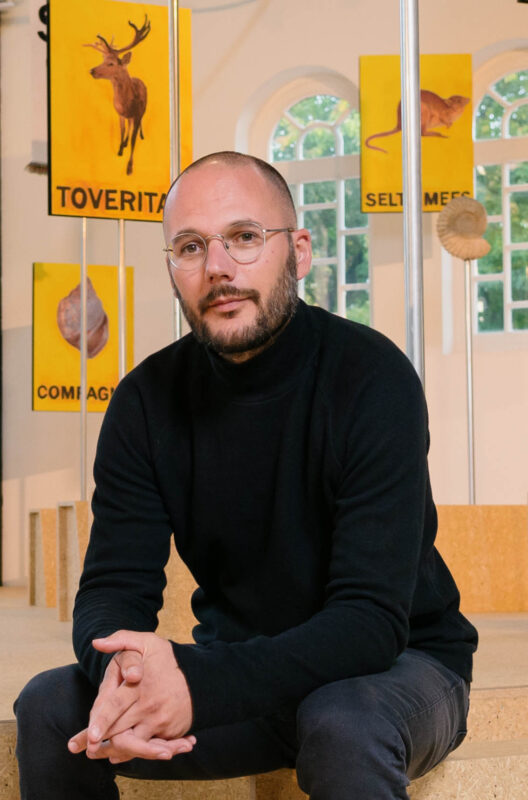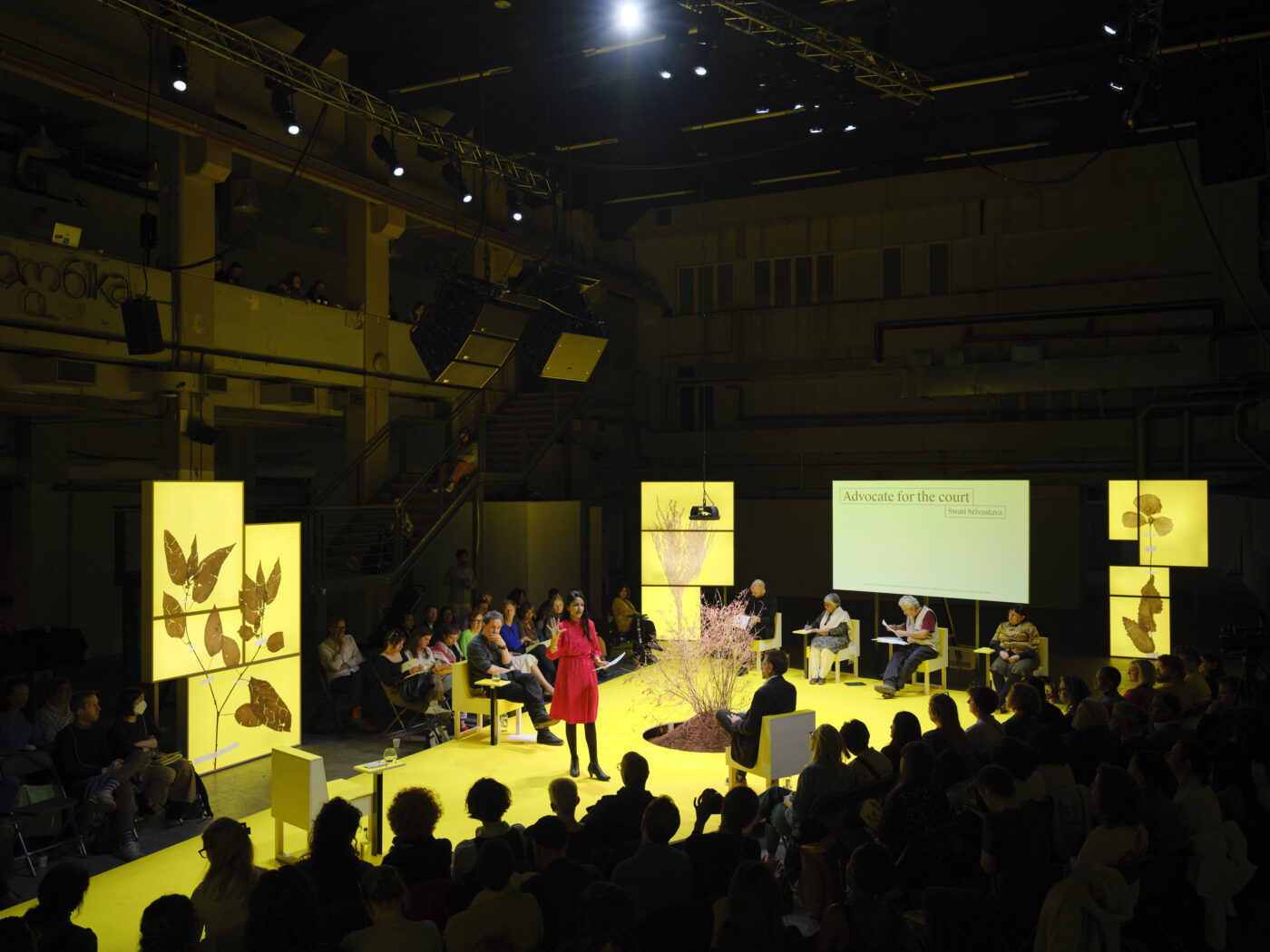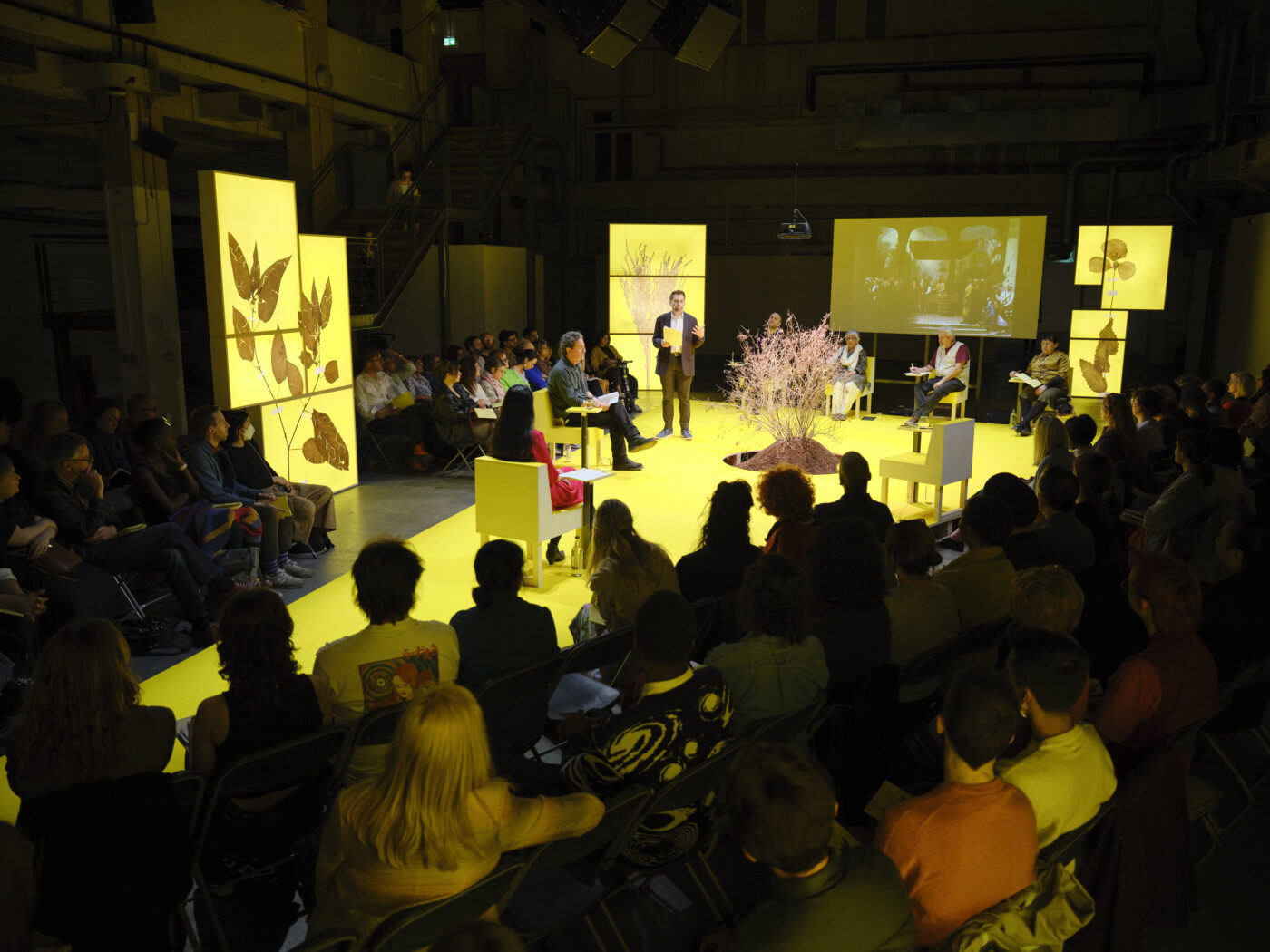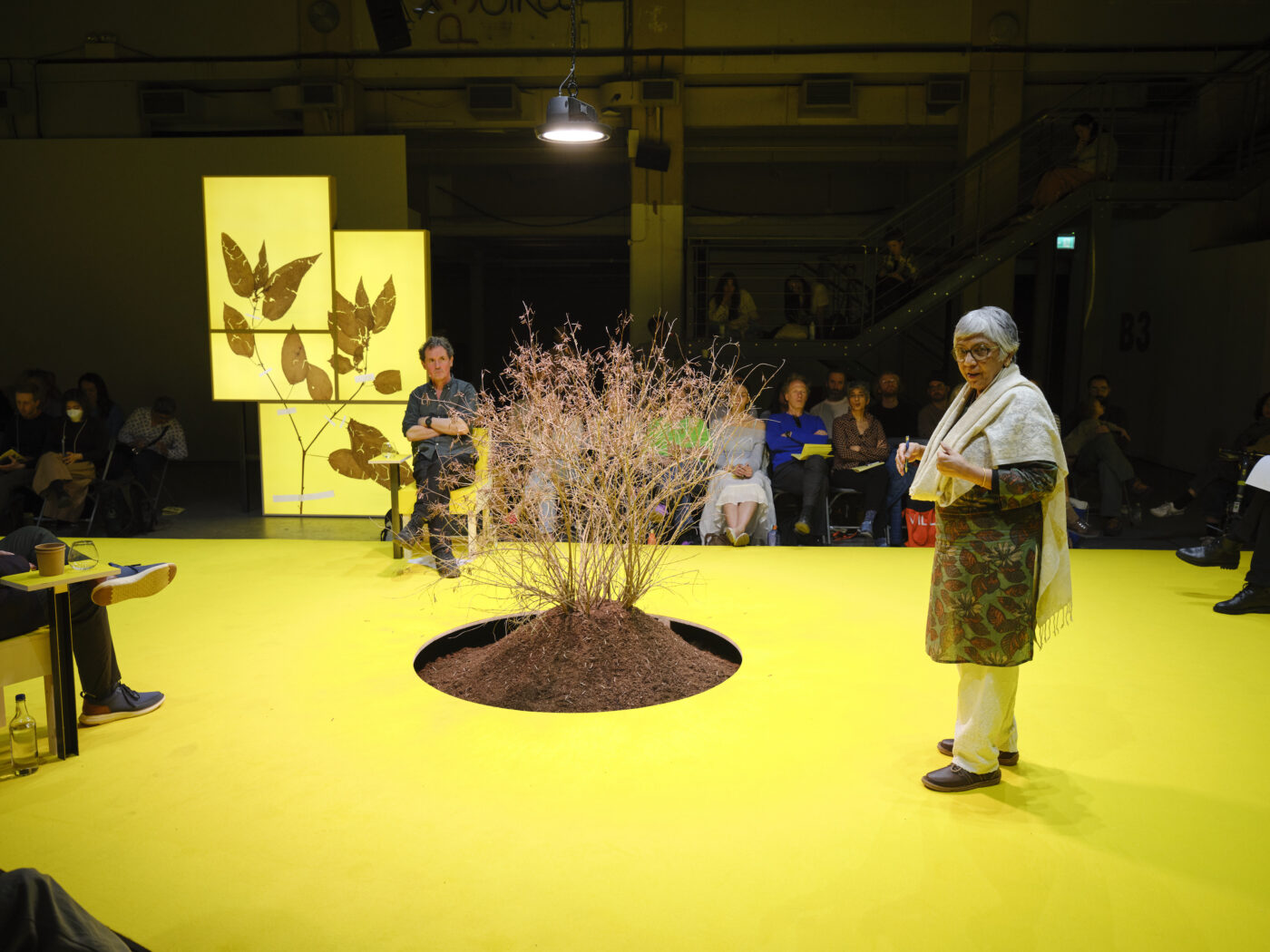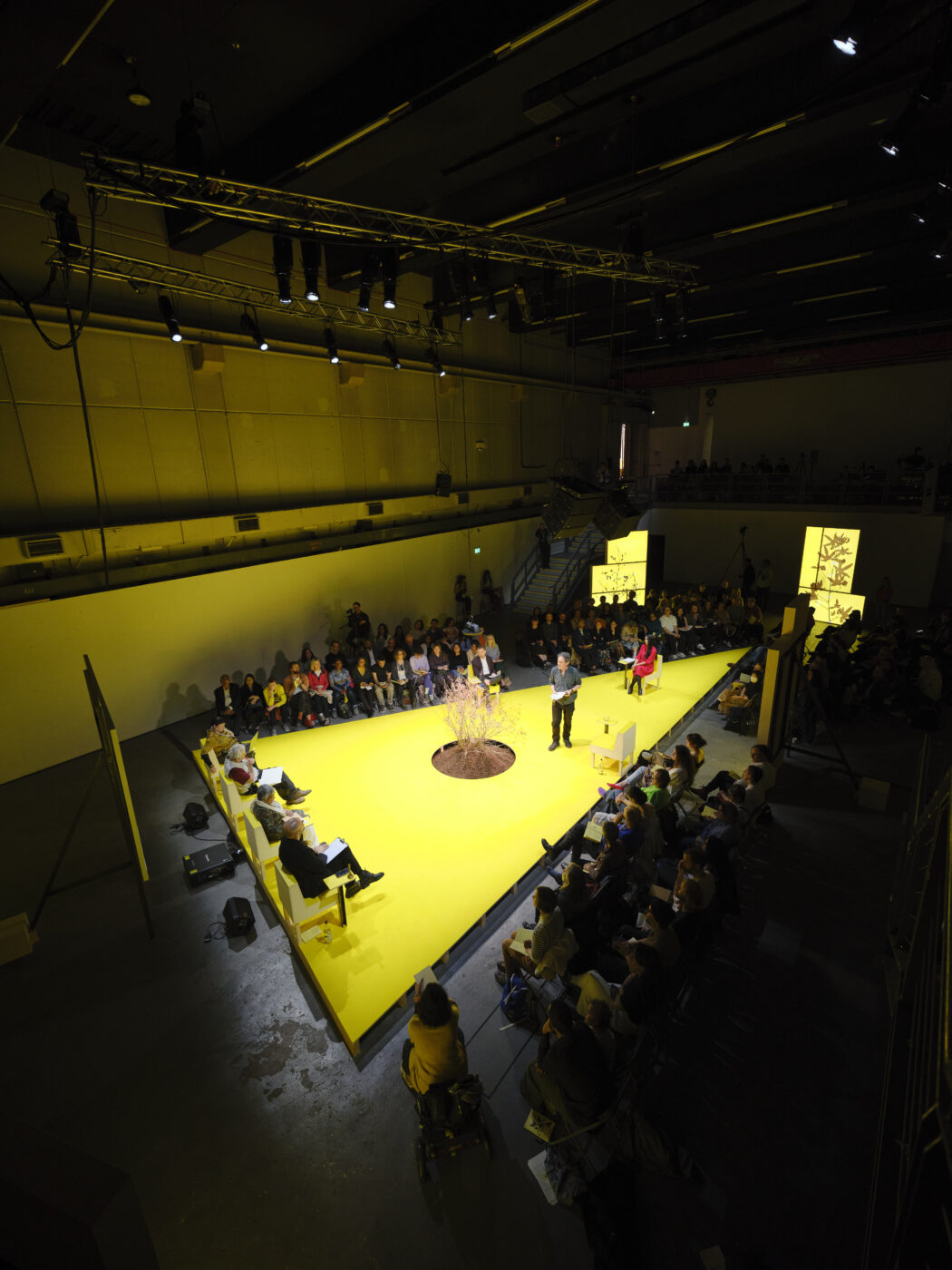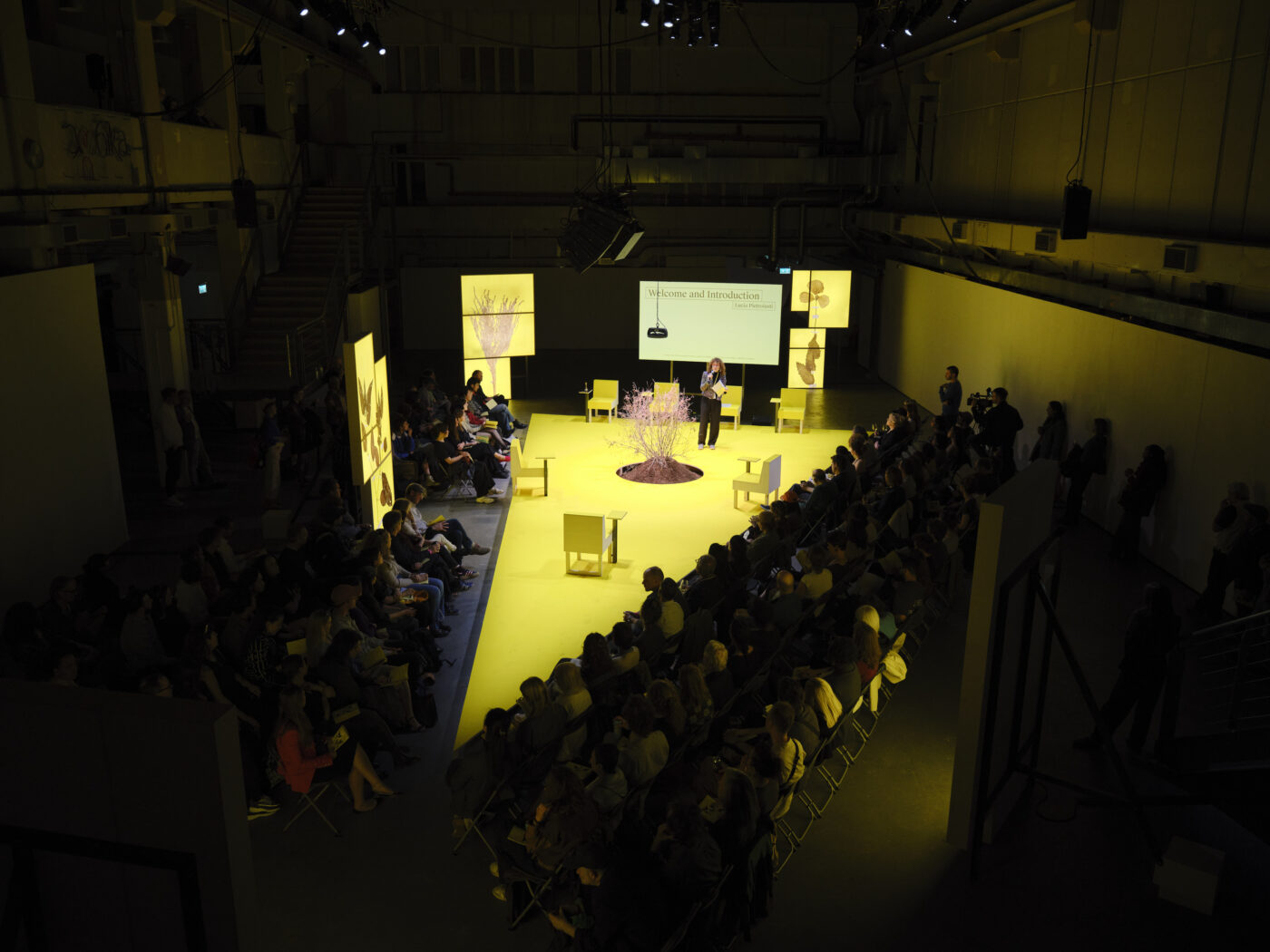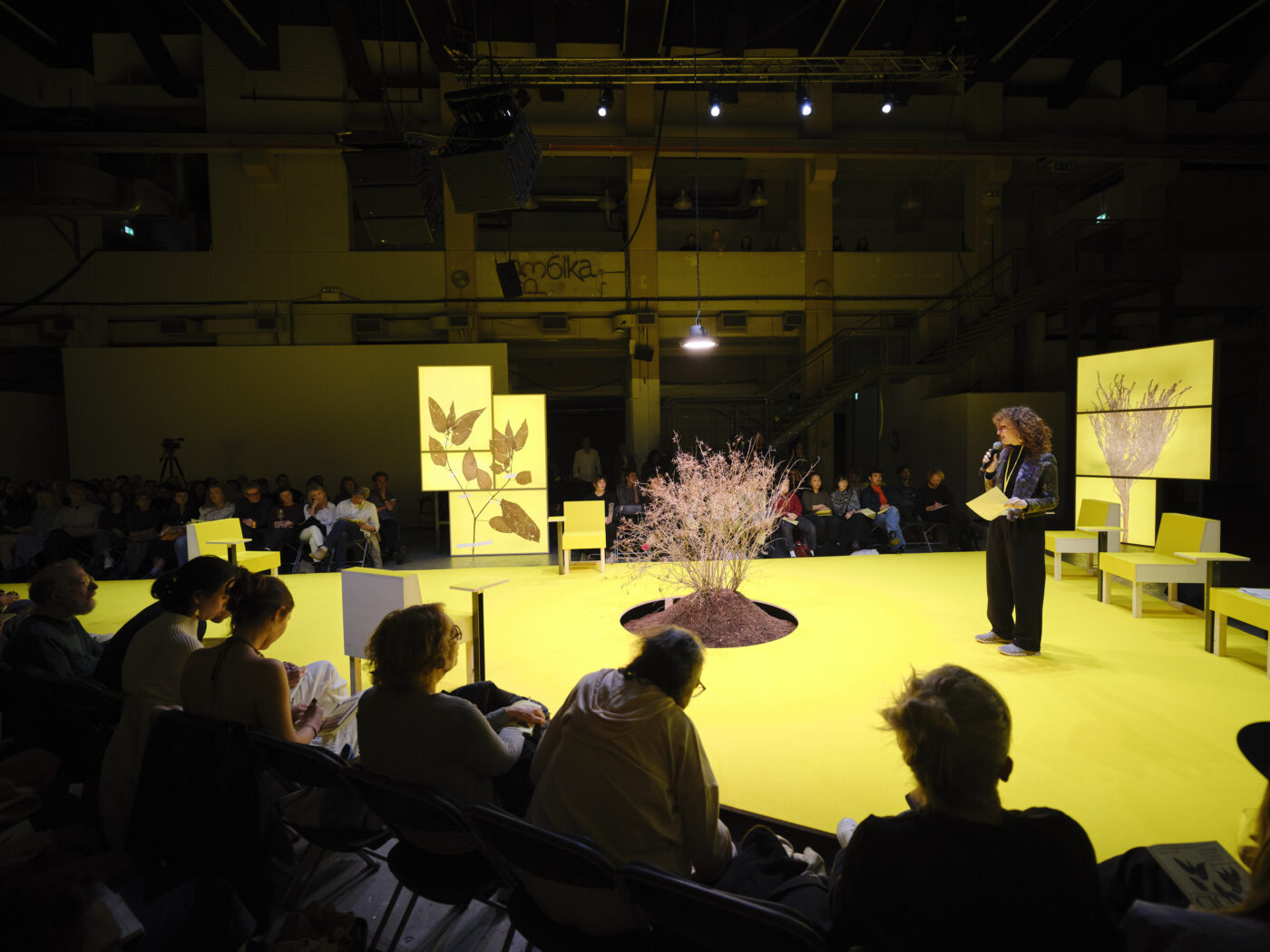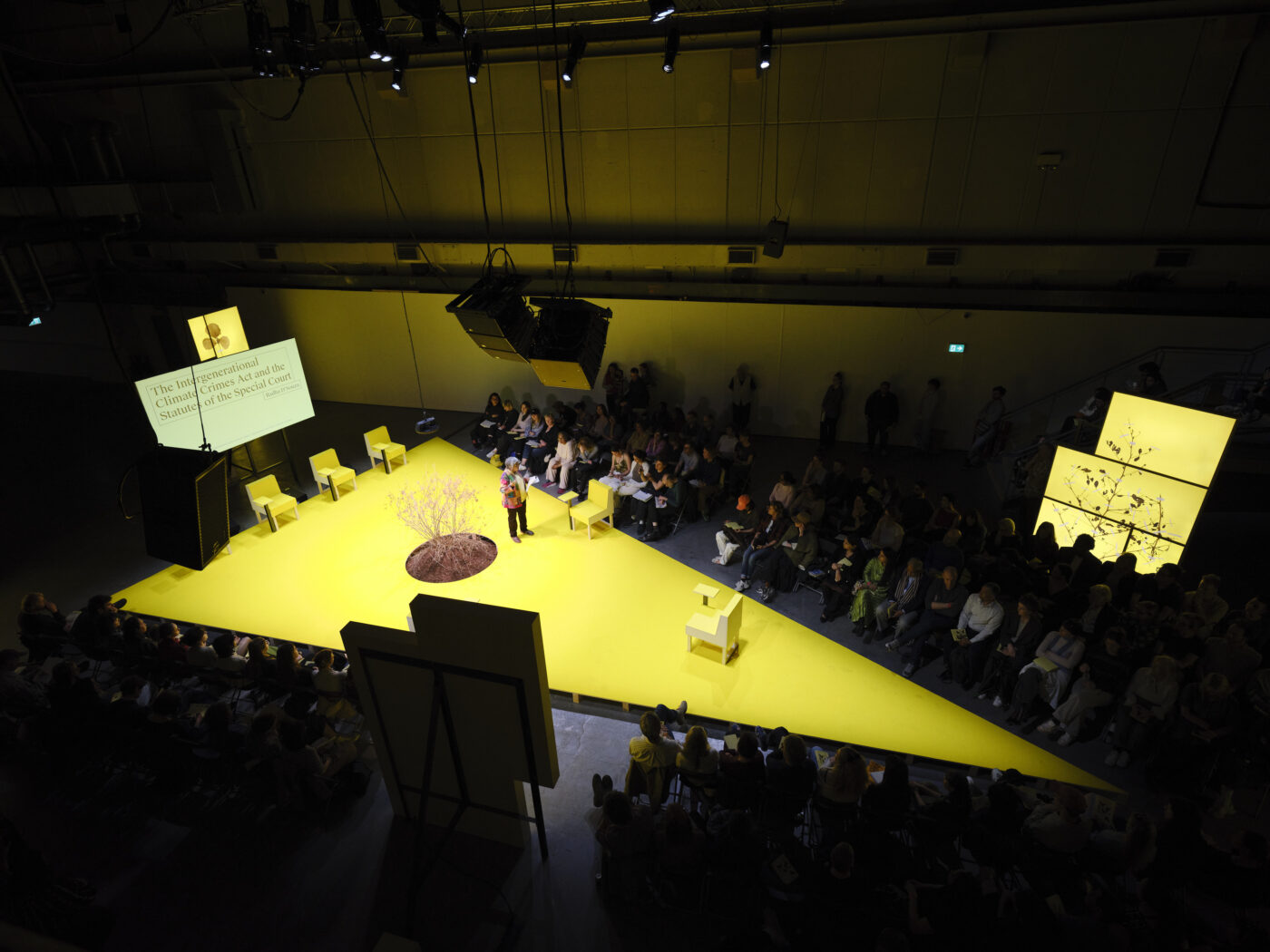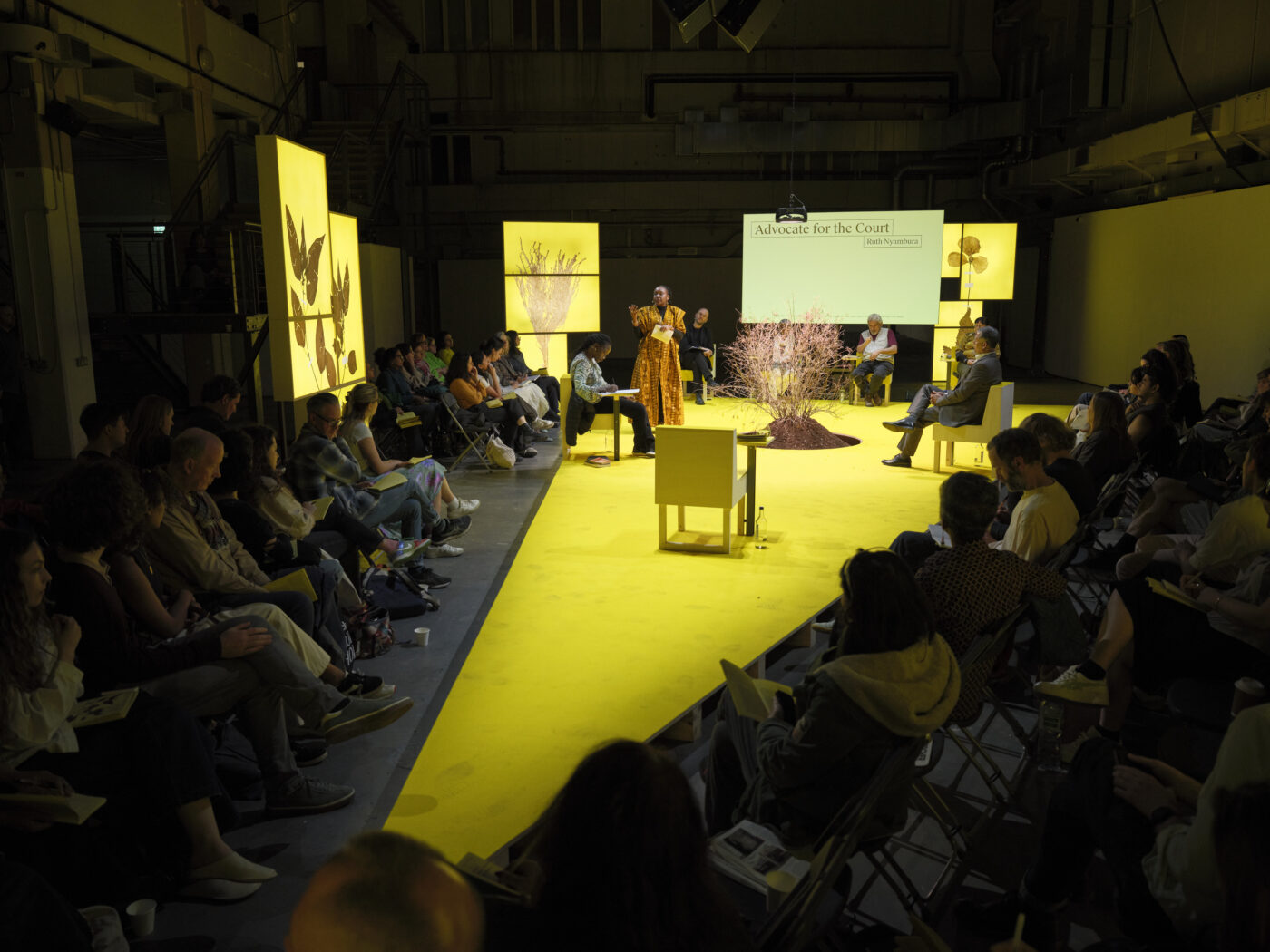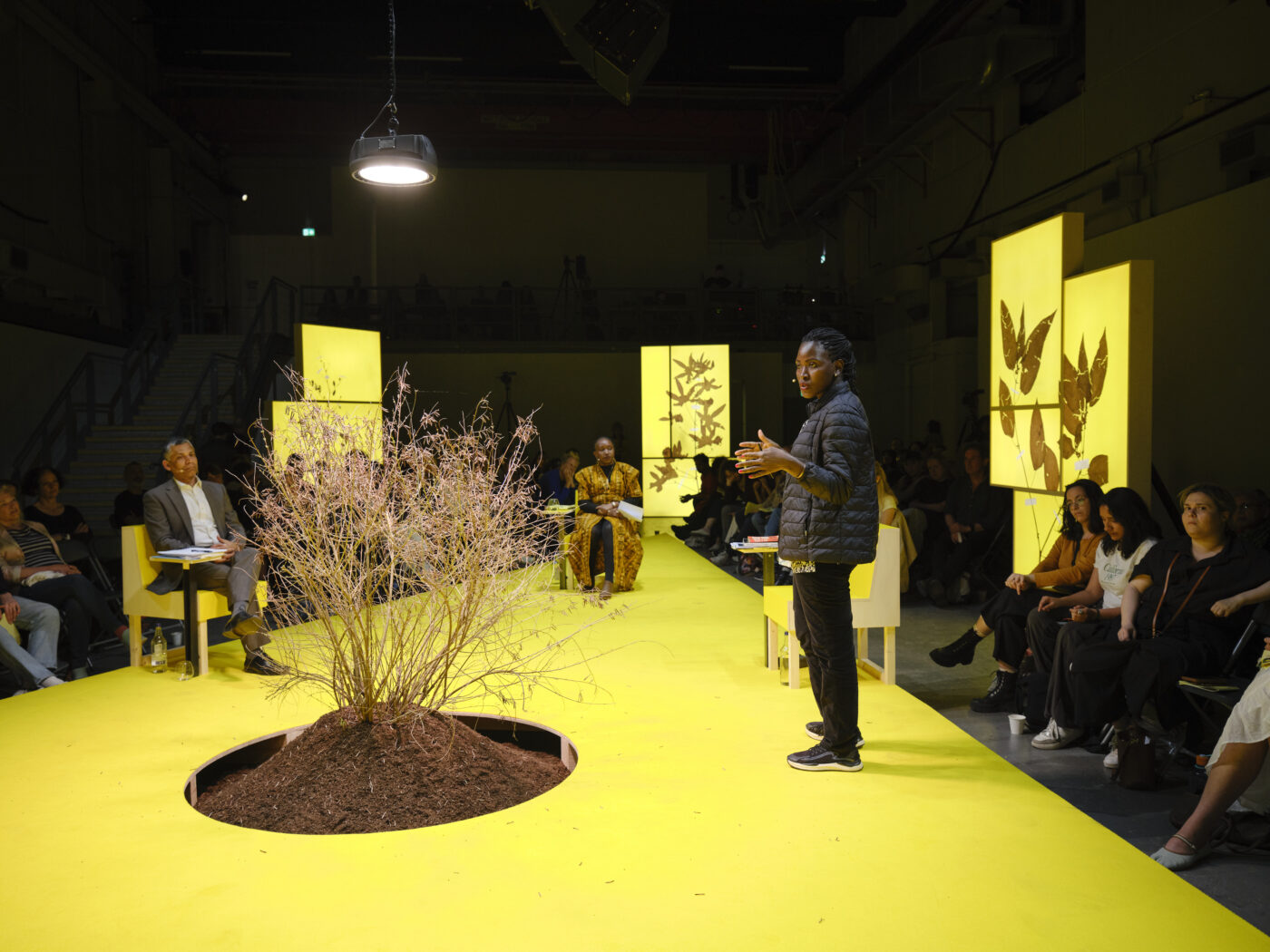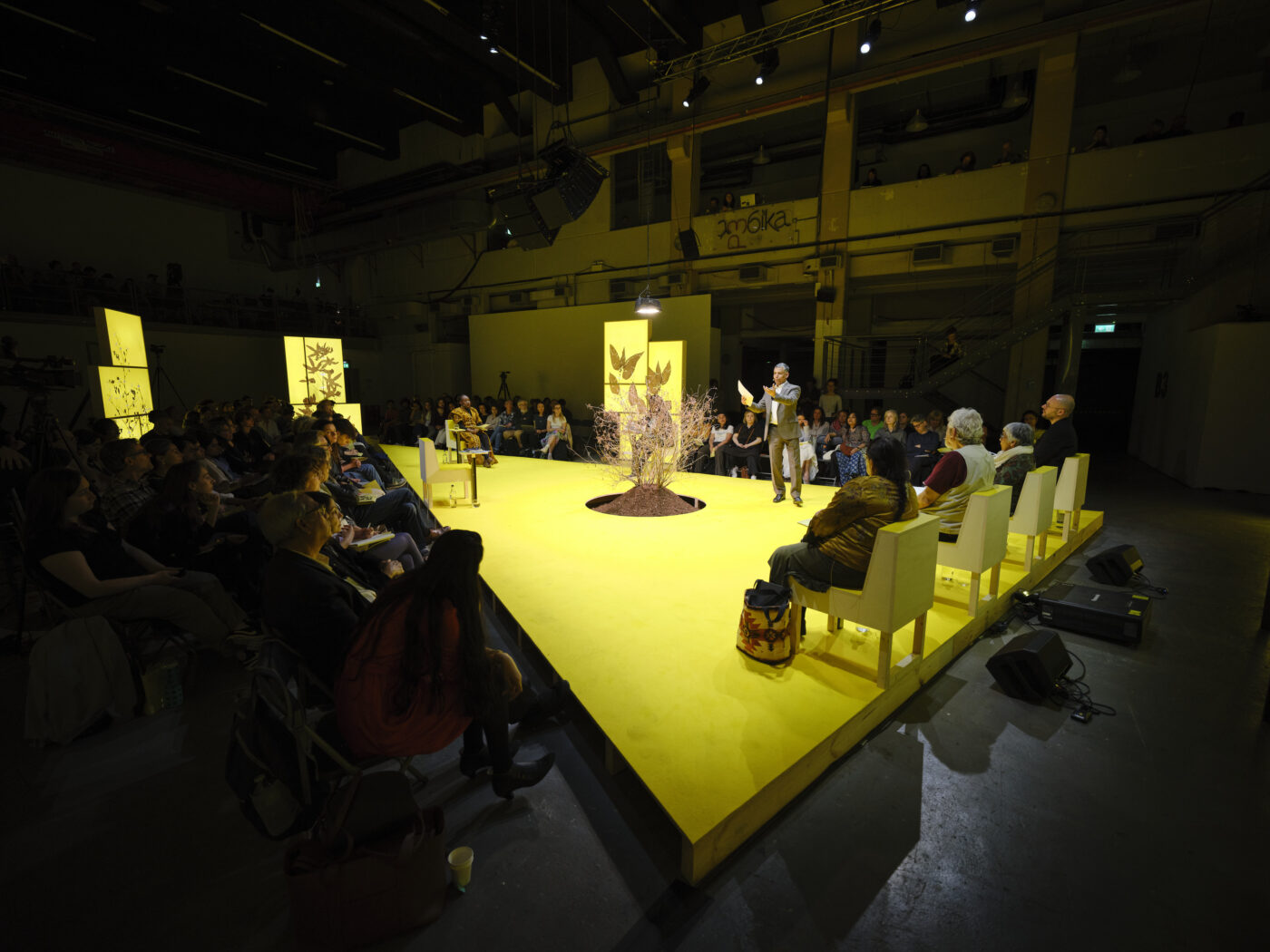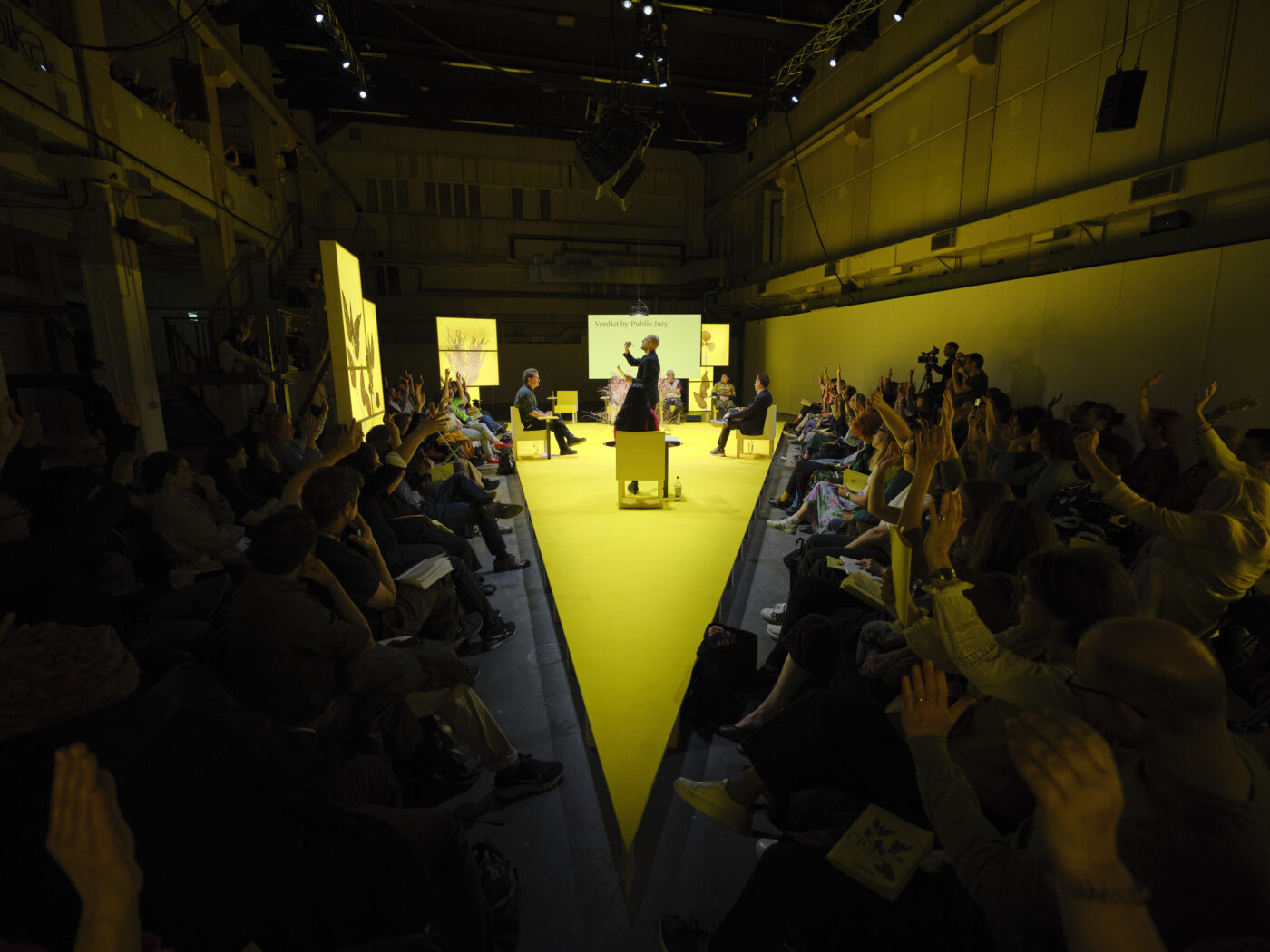Putting the Law on Trial: On the Court for Intergenerational Climate Crimes, Serpentine Galleries
The CICC London was only open to the public from 5 to 24 April 2025. Yet the experience of the public trials prosecuting The British East India Company for past crimes that affect our climate future, still lingers. Theresa Zwerschke, artist and writer for the mulit-lingual street magazine, Arts of the Working Class, shares her perspective in the following article.
Text: Theresa Zwerschke
28 April 2025
A year ago, I attended a trial at the Berlin Moabit Criminal Court where two climate activists were prosecuted for throwing paint on a Rolex store to protest the corporation’s complicity in ecological destruction. The paint had allegedly left irreparable damage to the window frames, and the activists were ordered to pay a large sum to restore the storefront.
I came to see the trial because a friend was involved in the defense. It was my first time witnessing a court case, and I was struck by the performativity of the proceedings, the state attorney’s impassioned speech about liberal values, the formal robes, and the defense’s quotation of Brecht in his closing speech. The trial became a stage for the theatrics of law and a clear example of its bias toward property. While the court pursued compensation for material damage, the activists’ motives, rooted in environmental justice, had no place within the legal framework. Justice here was demanded for a damaged window, but not for the ecological harm the corporation causes.
Most legal systems recognize only two kinds of entities: natural persons (humans) and legal persons (such as corporations or states), reflecting a juridical structure centered around the protection of human interests and capital. Non-human entities, for example, rivers or forests, are not regarded as legal entities and, thus, cannot seek justice or be represented in court. To claim justice on their behalf, they must first be granted legal personhood.
In recent years, several cases, led mainly by indigenous movements, have challenged this anthropocentric, proprietarian framework, advancing an ethic of ecological relationality. A key example is the Whanganui River in Aotearoa (AKA: New Zealand), which, after decades of a land rights struggle by the Whanganui iwi (Māori), became the first river recognized as a legal person under the Te Awa Tupua Act (2017).
This recognition, aligned with the Māori view of the river as an ancestor, is not merely a matter of representation. It challenges the limitations of juristic language and reveals the inherent values, biases, and power structures embedded in international legal systems. It exposes the paradox of seeking justice within systems that are themselves shaped by the very structures of oppression they purport to redress. It reveals how law is not a neutral tool, but instead a performative apparatus entangled with the legacies of racial capitalism, white supremacy, and anthropocentrism. Within such systems, many beings – human and more-than-human – remain unrecognized as legal subjects, and are excluded from the possibility of justice altogether.
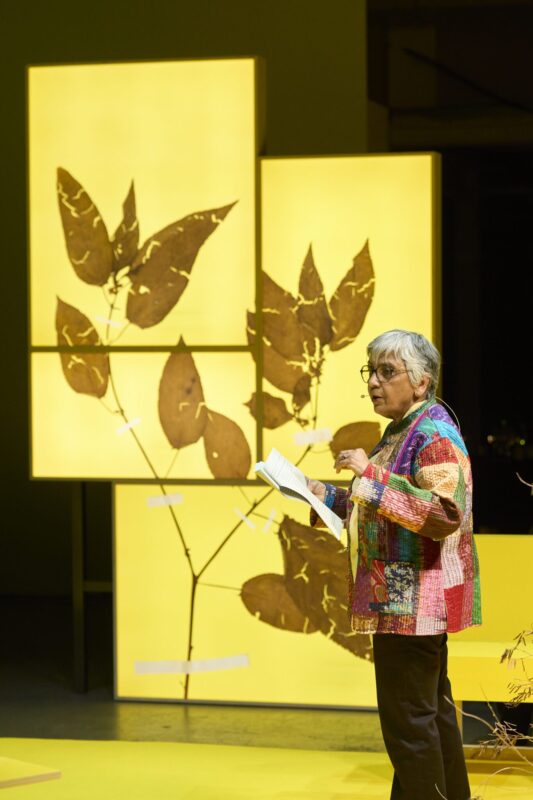
Radha D’Souza and Jonas Staal, Court for Intergenerational Climate Crimes: The British East-India Company on Trial, 2025. Commissioned by Serpentine Ecologies. Photos: Ruben Hamelink
The Court for Intergenerational Climate Crimes (CICC), which opened on April 4, 2025, at Ambika P3 as part of the Serpentine Gallery’s ongoing “General Ecology” program, had these concerns at its core. Initiated through a collaboration between the artist and researcher Jonas Staal and the writer, lawyer, and activist Radha D’Souza, the CICC was launched with a three-day program. This included an opening event and a series of court hearings that, taking Britain’s colonial legacy into account, placed the British East India Company on trial for its role in ecological destruction, displacement, dispossession, and the forced separation of people from land.
Following previous collaborations on the New World Summit – Utrecht (2016) and the New World Embassy: Rojava (Oslo City Hall, 2016), D’Souza and Staal launched the ongoing project CICC (Court for Intergenerational Climate Crimes) in 2021. Conceived as a large-scale tribunal intervention and public assembly, CICC seeks to prosecute ecological and colonial injustices perpetrated by states and corporations. Each iteration invites the public to participate as jury members, collectively enacting a demand for justice tied to the specific locality in which the tribunal takes place.
The first CICC, held at Framer Framed in Amsterdam (2021–2022), put the Dutch state, Unilever, ING, and Airbus on trial for their complicity in ecological destruction. The second iteration, part of the 14th Gwangju Biennale in South Korea (2023), focused on the role of the military-industrial complex in climate crimes, particularly in relation to the environmental devastation caused by warfare. This year’s CICC is staged in a former concrete testing factory in West London, now home to the contemporary art space Ambika P3 and located in the basement of Westminster Business School.
As I enter the basement on the evening of April 4th for the opening speeches by Jonas Staal and Radha D’Souza, the scene I step into reminds me of a TV talk show – well-lit, almost disarmingly staged. Yet with each detail that catches my eye, it becomes clear that the symbolism embedded in the set subtly unsettles this first impression, turning the spectacle inside out. The audience is seated around a yellow, triangular stage, on which seven matching wooden chairs are placed. The stage design draws inspiration from El Lissitzky’s propaganda poster Beat the Whites with the Red Wedge (1919/1920), created in support of the Bolshevik Red Army. In the original image, a red wedge pierces a white circle (symbolising the anti-communist Whites), its tip nearly reaching the center.
The yellow wedge stage echoes that same sense of directional force and ideological charge. While there is no literal circle for the yellow wedge-shaped stage to pierce in the space, the center of the stage features a circular cutout filled with soil, in which an indigo bush is planted. Throughout the hearings, this plant – referred to as “comrade indigo” – is acknowledged as a more-than-human witness to the proceedings. As the hearings unfold, the indigo plant releases its seeds across the courtroom, becoming a living metaphor for sowing disobedience, resistance, and the call for justice.
Surrounding the stage, four screens display images of cotton, jute, sugarcane, and papaver plants that played a central role in colonial trade and industry under the East India Company. Represented through images of herbarium sheets, the plant’s display not only positions them as witnesses and participants in the trial but also as evidence of the colonial discipline of botany, through which non-human life was classified, catalogued, and subsumed into a universalizing taxonomy. The stage thereby becomes both evidence of historical crimes and a space for cultivating new forms of comradeship between what D’Souza and Staal call “earthworkers,” as envisioned by the CICC.
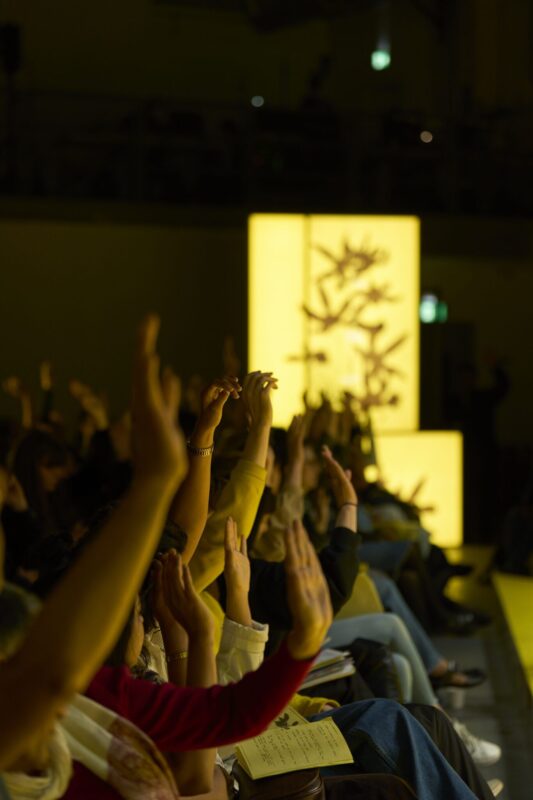
Radha D’Souza and Jonas Staal, Court for Intergenerational Climate Crimes: The British East-India Company on Trial, 2025. Commissioned by Serpentine Ecologies. Photos: Ruben Hamelink
The trial is opened by a communal reading of the Statutes of the Special Court on Intergenerational Climate Crimes 2025. The audience, considered a public jury, takes turns reading the statutes setting the ground for the hearings, which we are handed in a leaflet upon entering the space. Statue s.4(3) of the Act states:
Noting that a regular criminal trial is not suitable for bringing to light the criminal as well as civil aspects, and historical, and temporal aspects of intergenerational climate crimes […] [1]
Under the premise of contesting the insufficiency of the current legal structures to prosecute the crimes committed by the East India Company and the British Crown, the CICC exposes the inherent performativity of the law by restaging it as a theatrical, though not merely fictional, trial; one that does not mimic a traditional courtroom, but rather reimagines what justice could look like beyond the limits of existing legal frameworks. In the ensuing hearings, which presented three cases in front of the public jury/audience, Jonas Staal took on the role of the clerk, while Radha D’Souza, together with Ramón Vera-Herrera, and the Indigenous rights activist and writer Sharon H. Venne took on the roles of the judges.
Drawing on the historian James M. Vaughn’s research on the East India Company and the British Empire, alongside the journalist Andy Rowell’s investigations into the enduring ecological destruction they set in motion, the first hearing presented evidence of how the Crown/Company’s crimes persist through modern corporate-state alliances that shape central policies and practices. The second hearing focused on agricultural techniques and forced labor regimes in the indigo trade. The social justice activist Leonida Odongo testified to the harms caused by contemporary agribusinesses in Kenya, while Ghulam A. Nadri detailed how Company contracts legally bound peasants to forced labor, which also prevented them from cultivating their land. He explained how this led to deforestation, biodiversity loss, famine, and disruptions in local rainfall patterns. The final hearing addressed the forced separation of people from land. The historian Sudipto Mitra spoke about the impact of labor migration on indigenous life in Assam, describing how the East India Company’s forced labor system persisted through contract labor after slavery’s abolition. Migrant workers’ advocate Mostafa Henaway extended these insights to today’s global labor migration systems. Each hearing was followed by questions from the judges and public jury, collectively assembling a complex picture of the enduring impacts of these historical crimes.
At the end of each hearing, the public jury was asked to vote on a verdict. After the third and final session, the court closes with two concluding questions: firstly, whether the labor systems of the British Crown and the East India Company established a form of slavery that divided people and land; and secondly, whether transnational corporations have since expanded and embedded these systems, continuing to forcibly subject people and ecologies to exploitation. I raise my hand in agreement after both questions, along with everyone around me. Looking across the room, the verdict seems unanimous. No visible disagreement. What would happen if someone disagrees? The clerk notes the numbers, thanks are exchanged, and the court is formally adjourned.
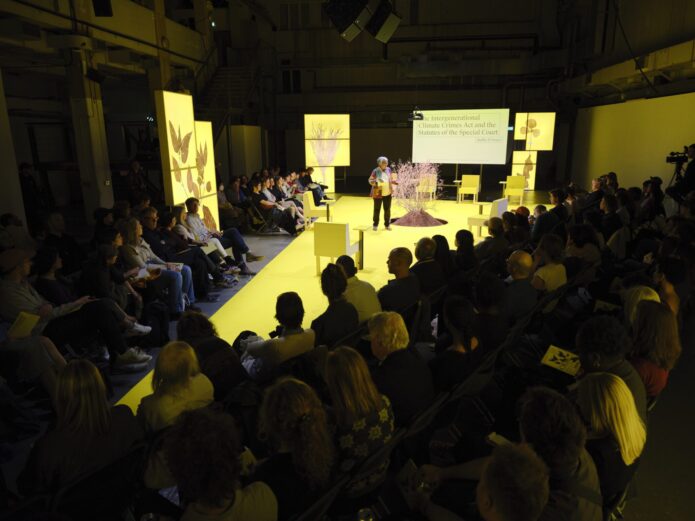
Radha D’Souza and Jonas Staal, Court for Intergenerational Climate Crimes: The British East-India Company on Trial, 2025. Commissioned by Serpentine Ecologies. Photos: Ruben Hamelink
Stepping out into the late Sunday sun, I carry a sense of irresolution, of having participated in a verdict that holds no weight beyond the performative space. What happens to justice when it exists only within the bounds of the symbolic? What responsibilities do we carry as participants in a trial that claims no institutional authority, yet demands accountability?
Reflecting on Point 13 of the Statutes’ Act that states: “CONSCIOUS that the interests of future generations of all species and intergenerational justice may require further actions by the CICC” [2]. I think of André Lepecki’s designation of the roles of audience members as either accomplices or witnesses. In his formulation, drawn from critiques of modernity as a continuous crime scene, the passive spectator becomes complicit by silently accepting their position within systems of violence. The accomplice is the one who attends and yet chooses not to act. In contrast, the witness is charged with the ethical task of testifying, of recounting, translating, and transmitting the ephemeral experience of the event across time. The witness does not merely observe but carries the responsibility of historicizing and activating what they’ve seen. For Lepecki, to witness is not just to remember but to activate memory into future responsibility.
If we, as the public jury, are not merely observers but also witnesses, then our role extends beyond the courtroom. The collectively reached verdict doesn’t necessarily remain symbolic when it becomes a task of transmission: to recount what we’ve seen and heard, and to transform the speakers’ testimonies into further acts of resistance, care, and justice that uphold the court’s verdict beyond the cultural space. Ideally, the Court for Intergenerational Climate Crimes does not end when the chairs are stacked and the lights turned off, but instead finds ways for its verdict to persist with a shared commitment to making its demands present beyond the courtroom by turning testimonies into actions.
The law wanted to know about desire as a thing that is or isn’t. The law wanted to know if the desire was in the poem. The law wanted to know if the poet’s desire made the poem mean. The poet wanted the law to read the entire poem. The law refused to do this. [3]
Contesting the law’s refusal to grasp the whole picture, the CICC offers an enactment that contains both a poetic desire and a revelation of the limitations of a legal system. As Jonas Staal stated in his opening speech, “The court is as real as we act it into being,” the trial highlights how legal systems rely on collectively upheld fictions. In a speculative mode of “what if,” this performative reenactment doesn’t aim to replicate the judicial process, but to challenge its exclusions, particularly its inability to prosecute historical and ecological crimes committed by the British East India Company, whose traces still reverberate in the present. In doing so, the CICC exposes the law’s foundations in violent logics of colonialism, anthropocentrism, and capitalism.
Leaning on the “fiction involved in law-making,” as Radha D’Souza describes it, opens the potential to activate the performativity of juridical processes as a rehearsal for new methods of justice, to speculate on an enactment of a trial that moves beyond its confines and expands into the question of what and who can be recognized within systems of accountability. As an exercise in putting the law on trial, the CICC reveals language and the speech act as its main constituting property. In naming the represented plants as witnessing comrades, the attending audience as public jury, and with organizers taking on the positions of clerk and judge to subvert legal vocabulary as the base for setting out the tribunal’s framework, Staal and D’Souza appropriate a juristical language to alter its forces and effects. The CICC opens a linguistic reality in which accountability is no longer anchored in institutional authority but emerges through a shared commitment to collective memory, testimony, and reimagination of justice.
Thinking with Anne Boyer’s “Poetry & the Law,” this effort to forge a language that embraces different life forms – as earth workers, comrades, legal entities – extends justice beyond the narrow realm of prosecution and gestures instead toward the generative, disruptive power of the poetic:
Poetry, when it regards law, regards law as that which is made of the same substance – language – but itself as what exceeds law’s bounds. The law, when it regards poetry, regards it as the means by which it might finally prosecute hearts. [4]
Text by Theresa Zwerschke
This article is re-published on the Framer Framed website with permission from the author and publisher. It was first published by Arts of the Working Class on 28 April 2025. Read the original article here.
Footnotes
[1] Court for Intergenerational Climate Crimes, CICC Pamphlet (2025), 33.[2] Court for Intergenerational Climate Crimes,, CICC Pamphlet (2025), 33.
[3] Anne Boyer, “Poetry & The Law”, in: A Handbook of Disappointed Fate, (New York: Ugly Duckling Presse, 2019), 206.
[4] Anne Boyer, “Poetry & The Law”, in: A Handbook of Disappointed Fate, (New York: Ugly Duckling Presse, 2019), 207.
- Arts of the Working Class - Putting the Law on Trial
- Ambika P3 - University of Westminster
- Serpentine Galleries
- Arts of the Working Class
Links
CICC / Ecologie / Extractivisme / Koloniale geschiedenis / Kunst en Activisme /
Exposities
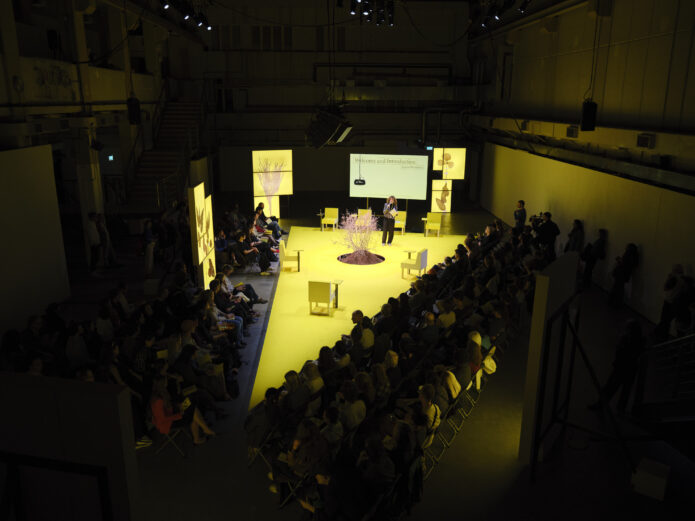
Expositie: CICC London – The British East India Company on Trial
Een tentoonstelling van het CICC in Londen over koloniale en industriële misdaden van de Britse kroon en de Oost-Indische Compagnie.

Expositie: CICC Gwangju Biënnale - Extinction Wars
Een tentoonstelling van de CICC in het Nederlands Paviljoen van de Gwangju Biënnale, Zuid-Korea, geproduceerd en opgedragen door Framer Framed.
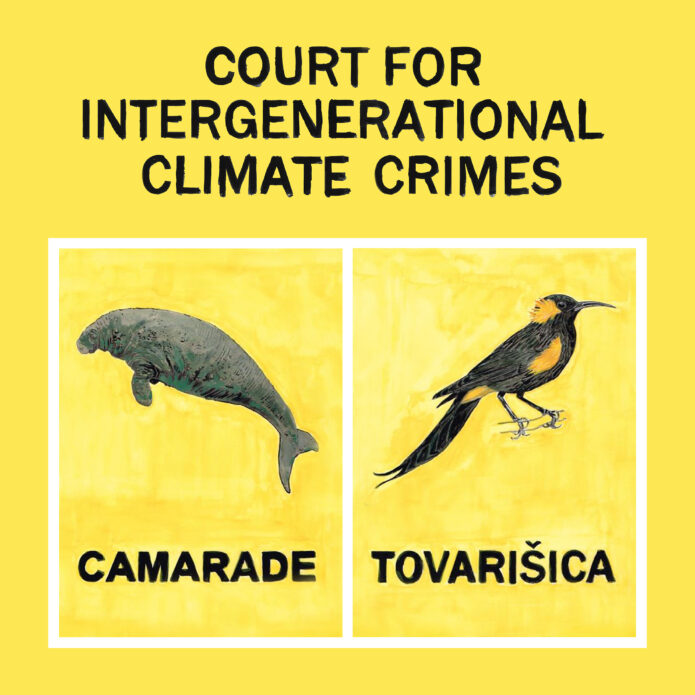
Expositie: Court for Intergenerational Climate Crimes
Een project van Radha D'Souza en Jonas Staal
Agenda
CICC School London – Indigo Resistances: Sonic and Textile Testimonies
Kunstenaars Antonio Jose Guzman & Iva Jankovic (Messengers of the Sun) bespreken de koloniale erfenis van de handel in indigo
Netwerk
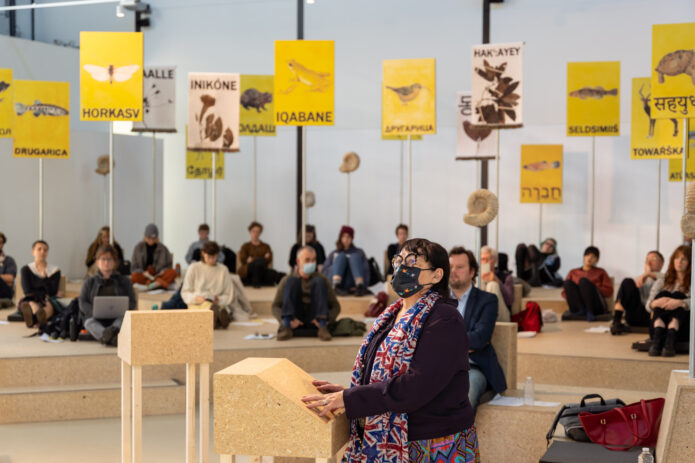
Sharon H. Venne
Cree geschiedschrijver
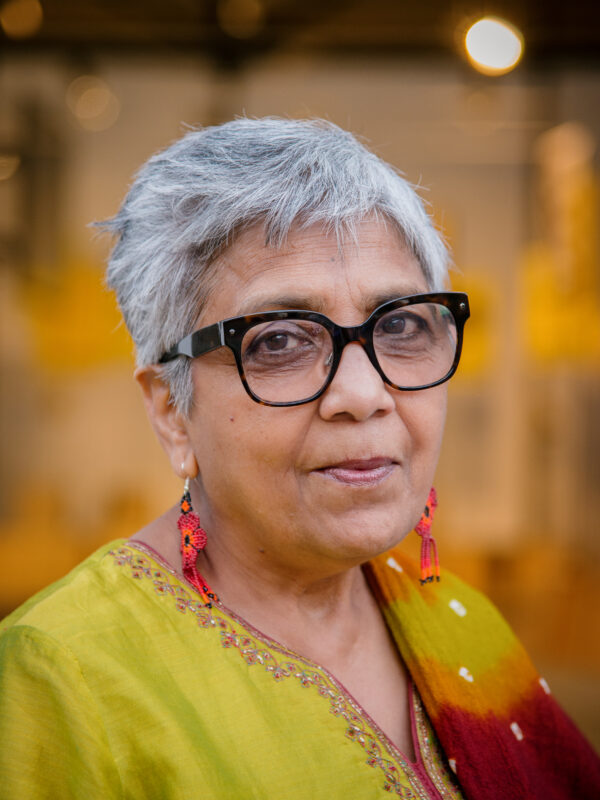
Radha D'Souza
Schrijver, onderzoeker, advocaat en activist
